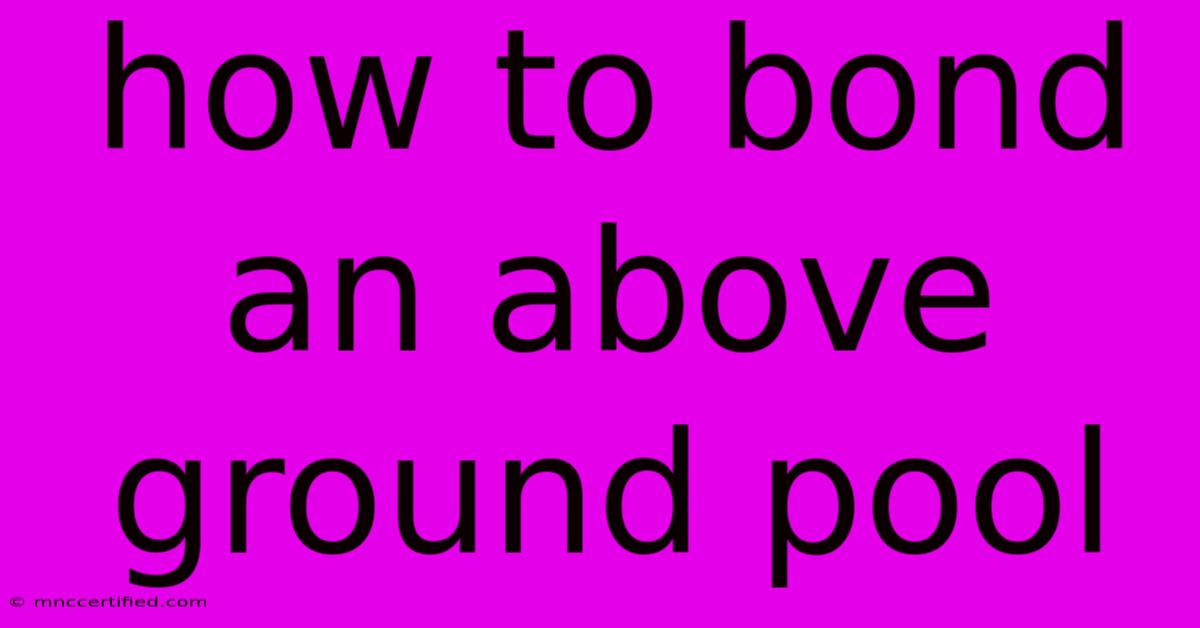How To Bond An Above Ground Pool

Table of Contents
How to Bond an Above Ground Pool: A Comprehensive Guide to Safety and Compliance
Above-ground pools offer refreshing summer fun, but safety should always be the top priority. Proper bonding is crucial for protecting you and your family from electrical shocks. This comprehensive guide will walk you through the process of bonding your above-ground pool, ensuring compliance with electrical codes and maximizing safety. We'll cover everything from understanding the why to the how, equipping you with the knowledge to complete this vital task.
Why Bond Your Above Ground Pool?
Bonding your above-ground pool is not just a good idea; it's a necessary safety precaution. It involves connecting all metallic parts of your pool structure—including the pool shell, ladder, handrails, and any other conductive metal components—to a common electrical ground. This creates a single equipotential plane, preventing voltage differences that could lead to dangerous electrical shocks.
Here's why it's so important:
-
Preventing Electrical Shocks: If a stray electrical current enters the water—perhaps from a faulty underground cable or a lightning strike—bonding ensures that the voltage is evenly distributed, minimizing the risk of a lethal shock.
-
Meeting Electrical Codes: Most local building codes mandate pool bonding for safety reasons. Failure to bond your pool could result in fines or even legal repercussions.
-
Protecting Your Investment: Electrical surges can damage pool equipment. Proper bonding helps protect your pumps, filters, and other valuable components.
What You'll Need to Bond Your Above Ground Pool
Before you begin, gather the necessary materials. You'll need:
- Copper Bonding Wire: Use appropriately sized copper wire, usually #6 or #8 gauge, depending on your local electrical code and the size of your pool. Larger pools might require thicker wire.
- Bonding Clamps: These clamps are designed to securely connect the bonding wire to metallic pool components. Ensure they are rated for outdoor use and corrosion resistance.
- Ground Rod: A properly sized and driven ground rod provides a reliable connection to the earth. Its length will depend on your soil conditions.
- Ground Wire Connector: This connector securely links the ground rod to your bonding wire.
- Voltage Tester: Once you've finished bonding, you'll want a voltage tester to confirm that everything is working as it should.
- Tools: A shovel, hammer, wire cutters, pliers, and a screwdriver will be necessary.
Step-by-Step Guide to Bonding Your Above Ground Pool
Follow these steps carefully to ensure proper bonding:
-
Identify Metal Components: Locate all metallic parts of your pool structure that need bonding. This includes the pool shell (if metal), ladder, handrails, light fixtures (if metallic), and any other conductive metal elements.
-
Install the Ground Rod: Drive a ground rod (typically copper-clad steel) at least 8 feet into the ground, away from the pool, following local regulations and code recommendations. Ensure it's deeply embedded to maintain effective grounding.
-
Connect the Ground Rod: Securely attach the ground wire to the ground rod using a ground wire connector.
-
Attach Bonding Wire: Use bonding clamps to firmly connect the bonding wire to each metallic component of the pool. Make sure the connections are tight and secure to prevent corrosion and loose connections.
-
Connect to the Ground Rod: Run the bonding wire from each component to the ground rod, ensuring a continuous connection.
-
Inspect Connections: Visually check all connections to ensure they're secure and properly grounded. Look for any signs of corrosion or damage.
-
Test Your Work: Use a voltage tester to verify that all bonded components are at the same electrical potential. If there are any voltage differences, re-check your connections.
Important Considerations:
- Local Codes: Always check your local building codes and electrical ordinances for specific requirements regarding pool bonding. Regulations can vary significantly.
- Professional Installation: If you're unsure about any aspect of the bonding process, it's best to consult a qualified electrician. Improper bonding can be dangerous.
- Regular Inspection: Regularly inspect your bonding system for any signs of corrosion or damage. Replace any damaged components immediately.
Maintaining Your Pool's Bonding System
A properly bonded pool is a safe pool. To maintain safety, regularly inspect your bonding system for any signs of corrosion, loose connections, or damage. Clean and tighten connections as needed. Consider scheduling a yearly inspection by a qualified electrician to ensure your system remains effective.
By following these steps, you can ensure your above-ground pool is safely bonded, providing peace of mind and protection for your family and friends for years to come. Remember, safety should always be your top priority.

Thank you for visiting our website wich cover about How To Bond An Above Ground Pool. We hope the information provided has been useful to you. Feel free to contact us if you have any questions or need further assistance. See you next time and dont miss to bookmark.
Featured Posts
-
Brazil Vs Uruguay Result 1 1 Draw
Nov 20, 2024
-
White Light Investment Management
Nov 20, 2024
-
Labaron Philon Alabamas Draft Ascent
Nov 20, 2024
-
Linda Mc Mahon Nominated Education Secretary
Nov 20, 2024
-
Pokemon Trading Card Game Sleeves
Nov 20, 2024